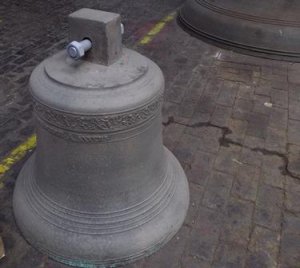The historic Zeebrugge Bell, presented to the people of Dover by the King of the Belgians, Albert I, is undergoing conservation and repairs at the UK’s last working bell foundry, as preparations get underway to mark the centenary of one of the most significant naval engagements of World War I.
Work on the Zeebrugge Bell is being undertaken by John Taylor & Co. in Loughborough. The work includes cleaning the bell and rehanging it on new fittings. Alongside conservation of the bell, Dover District Council has contracted Walmer-based Hipperson Builders to undertake conservation works to the stonework, window and door fittings around the Zeebrugge Bell housing.
The Zeebrugge Bell is housed at Dover’s Grade I listed Maison Dieu and is struck each year by the Town Mayor at noon on St George’s Day (23 April) as part of annual commemorations organised by Dover Town Council to mark the anniversary of the raids on the Belgian ports of Zeebrugge and Ostend. This audacious attempt to block German U-boats from entering the English Channel involved over 70 ships and 1,000 men, many of them volunteers from the Royal Navy and Royal Marines. Casualties were high with 200 dead and over 400 injured. Eleven Victoria Crosses and 679 other decorations were awarded for bravery.
The Zeebrugge Bell was hung at the harbour entrance at Zeebrugge and used to warn of enemy attack. It was presented to the Corporation of Dover in 1918 by HM The King of the Belgians through Vice Admiral Sir Roger Keyes of the Dover Patrol who masterminded the raids. Admiral Keyes is buried at the St James Cemetery in Dover, which is also the final resting place of 66 other servicemen who died in the raids.
Preparations are underway for events to mark the centenary of the raids in 2018 in both Dover and Deal. Many of the Royal Marines involved in the raids trained at the Royal Marines Depot in Walmer.
Ringing out anew - Dover's historic Zeebrugge Bell
Tuesday, 24 October 2017
More news...
- DDC shortlisted for Keep Britain Tidy's Network AwardsThursday, 15 December 2022Dover District Council has been shortlisted for a Keep Britain Tidy Local Authority Network Award. The 'Great British Spring Clean Award 2023' recognises promotion, engagement, and delivery of The Great British Spring Clean Campaign.DDC shortlisted for Keep Britain Tidy's Network Awards
- Dover choir to give Christmas concert at St Paul's Roman Catholic ChurchMonday, 28 November 2022
 An award-winning Dover choir will be giving their Christmas concert next month - the first with their new musical director.Dover choir to give Christmas concert at St Paul's Roman Catholic Church
An award-winning Dover choir will be giving their Christmas concert next month - the first with their new musical director.Dover choir to give Christmas concert at St Paul's Roman Catholic Church - The Big Dover Jobs & Skills FairThursday, 6 October 2022Over 600 jobs will be on offer along with a host of skills and training opportunities at the Big Dover Jobs & Skills Fair at the Port of Dover's Cruise Terminal Two on Tuesday, 18 October.The Big Dover Jobs & Skills Fair
